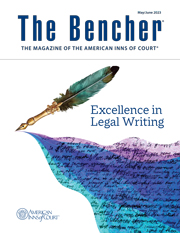The Rise of the ‘Cheeky Amici‘
The Bencher—May/June 2023
By Raffi Melkonian, Esquire

 Amicus practice has been growing increasingly important to Supreme Court of the United States advocates (and even to lawyers in state supreme courts and intermediate courts of appeals) in the past decade. What some academics have called the “amicus machine” whirs into operation in nearly every Supreme Court case. Specialist law firms assign associates—sometimes referred to internally as the “amicus king” or “queen”—to reach out to important interest groups for contributions to the case. Merits parties think hard about which amicus briefs they want to see and, just as important, which they do not. Rather than leaving all to chance, as perhaps they used to, they craft an amicus strategy. And thus, in the most important cases, a flood of amicus curiae briefs blankets the court with light green pamphlets.
Amicus practice has been growing increasingly important to Supreme Court of the United States advocates (and even to lawyers in state supreme courts and intermediate courts of appeals) in the past decade. What some academics have called the “amicus machine” whirs into operation in nearly every Supreme Court case. Specialist law firms assign associates—sometimes referred to internally as the “amicus king” or “queen”—to reach out to important interest groups for contributions to the case. Merits parties think hard about which amicus briefs they want to see and, just as important, which they do not. Rather than leaving all to chance, as perhaps they used to, they craft an amicus strategy. And thus, in the most important cases, a flood of amicus curiae briefs blankets the court with light green pamphlets.
One recent example tells the tale. In National Pork Producers Council v. Ross, a case involving a challenge to California’s new animal welfare laws, petitioners deployed 21 amici curiae, while California fielded 24. And Pork Producers is just a median case—other matters that involve the highest stakes attract hundreds of amici filings.
What is the point of all this legal writing? To be sure, some participants hope to influence the final decision by providing the court with new information. Academics have deeply considered views that they would like the court to adopt. But amicus briefs have always been filed for reasons other than persuasion: good amicus briefs help organizations or counsel raise their profiles, fundraise, or make points for political battles that will be waged outside the narrow confines of the courthouse walls. Even so, these types of briefs were not very different on their face than the more traditional kinds of amicus briefs. Yes, they are meant for public consumption, but fundamentally, they still sought to provide the courts with traditional legal arguments.
All that seems to be changing. In the past year, parties have filed several extremely unorthodox briefs in important cases around the country. In one, the satirical newspaper The Onion filed a parody brief announcing that it “owns and operates the majority of the world’s transoceanic shipping lanes” and touting its favorable citations by “Chinese state-run media”—to press its point that parody must be done seriously to be funny. The ACLU filed an amicus brief involving criticism of public figures bemoaning the “The Ridiculous Case at Hand.” The brief included a footnote that consisted entirely of the sentence “Everyone is allowed to have dreams.”
The most recent example is perhaps the most startling. The Supreme Court is now considering Jack Daniel’s Properties, Inc. v. VIP Products, LLC, a case asking whether the humorous use of another’s trademark is subject to normal Lanham Act scrutiny. In short, the case is about a dog toy that makes fun of Jack Daniel’s iconic whiskey bottle. An avant-garde fashion house, MSCHF, filed an amicus brief consisting almost entirely of connect-the-dot pictures, personalized for each justice and each Supreme Court law clerk. The brief instructs the justices to finish the picture they have been assigned and mail the “work of art” back to the authors. And to help the justices in this task, MSCHF even sought to provide the court with a box of colored pencils.
This sort of “cheeky amici” brief is new and clearly different from amicus briefs in the past. These briefs offer very little traditional legal argument. Instead, the briefs aim to be funny and sharp, focusing on influencing the public or attracting media attention. Should lawyers across the country take these briefs as examples for their own writing? There, the answer is more shadowy. Even while the briefs have been praised as innovative, some observers have already castigated them for flirting with disrespect for the courts. Even more important, it seems likely that if this trend continues, courts will act to limit their use.
Courts do not take kindly to the perception that their dockets are being used to garner publicity for litigants and counsel. In the end, what I will take from these new briefs is that a little frivolity and lightheartedness can make an otherwise sound legal argument stand out. One need not go all the way to sending Chief Justice of the United States John G. Roberts Jr. an art project to incorporate some new methods into your brief writing. But, your clients and the courts may appreciate it.
Raffi Melkonian, Esquire, is an appellate partner at the Houston, Texas, law firm of Wright, Close & Barger LLP. He litigates appeals in the state and federal courts of Texas and around the United States. He can be reached at melkonian@wrightclosebarger.com. Melkonian is Master of the Bench member of the Garland R. Walker American Inn of Court.